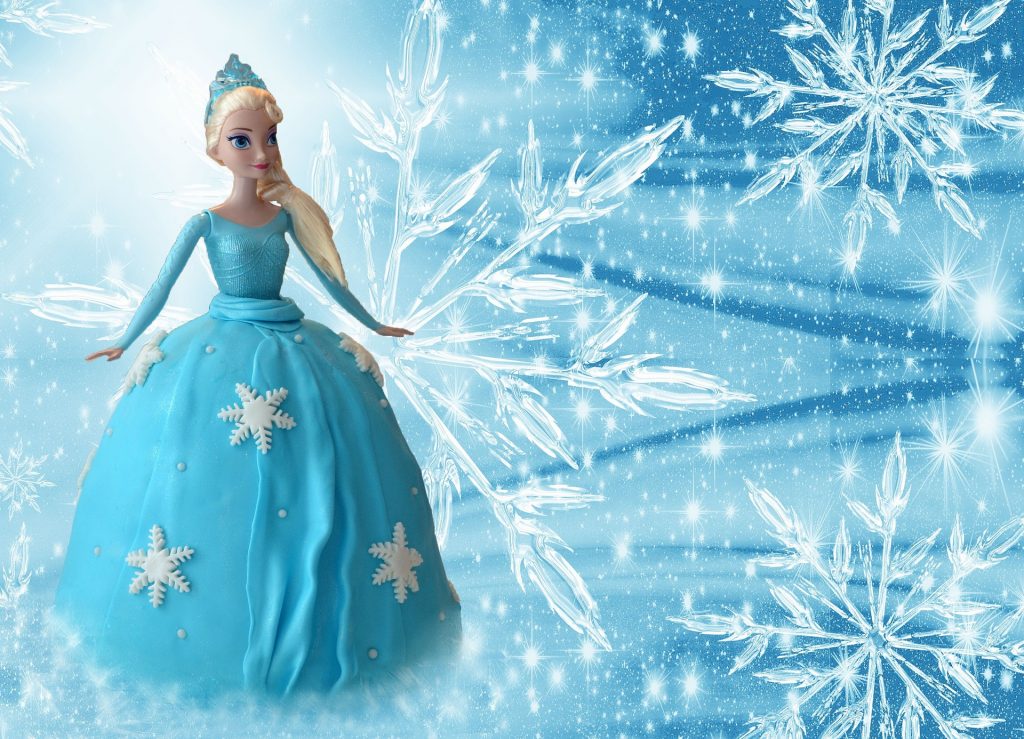It is wellknown that Disney films have a longstanding tradition of heroines whose adventure often ends in a wedding dress. But “Frozen” (USA 2013) is remarkably different. It is an interesting question whether Disney actually intended what ultimately came of it.
The special element of the movie
In this case the fact that the love between two sisters holds the salvation. Not, as so often, the love between man and woman. This is unusual and it seemed so worthwhile to the makers that they made it the core of the story.
Screenwriter Jennifer Lee is quoted saying that they knew from the start that the love of the sisters was the key to the resolution of their story. Even though they didn´t know how. But this “knowing” is what I like to describe as the “magic” of a story, when it´s gestalt begins spellbinding you even though you cannot explain why. But the emotional , often mythological truth is tangible. To discover it means finding a powerful seed that can be brought to flower.
The film is unusually successful. Not only because of the legendary the business acumen and the apt handling of advertising at Disney is legend, they do the same for their other films like the preceding “Tangled” (USA 2010) – but only “Frozen” became the most successful animation film ever and is considered the fifth most successful movie of all time. So what is this very magic, that makes the movie so successful?
I received a first clue when a few of my American girlfriends, but also a couple in Germany told me that the song “Let it go” is sung with extreme enthusiasm by their daughters, mostly at the age between 4 and 12, and that very often and not always with a talent for singing. There is even an amusing Youtube Clip with a highly annoyed mom, who listens to her daughter singing and constantly repeats to herself: “Yepp, just let it go…let it go..:” One can clearly sense that this mother is deeply wishing that her daughter would let go of the song, or rather, the song would let go of her. For many girls seem to be particularly captivated by Elsa and her song. The famous chorus “Let it go” is repeated three times, each time slightly varied and was translated into at least 25 languages. (There is lovely clip on youtube, with a montage of all the singers filmed while recording, each singing one line).
As so often with Disney, music, text and images are perfectly matched: while Elsa is turning visually from a well-behaved and fearful little girl that is ashamed of her terrible gift into a self-confident young woman with a sexy dress and lascivious hairdo and expresses her power with relish, she sings about how she is letting go of all and will not yield to any further limitations. While she is creating herself an icy palace and an elegant gown, she also acknowledges her ability and her new freedom and willingly accepts the solitude in turn. For now she can be her unleashed self… That there actually is a way to unite her power and social interaction is not yet of concern at that point of the movie.
This choice of total self-determination and acceptance of her own creative powers and the responsibility for it – even though it means loneliness at first – has an enormous dramatic and mythological impact, especially for young women. In my opinion this is one of the main reasons for the success of the movie.
The evil antagonist turns into a good contagonist
The story is loosely based on the Danish fairytale “The Snowqueen” by Hans Christian Andersen and has little in common with this version. The original version can be found on various websites and that´s why I will not reiterate it here. Besides not the amount of changes is interesting here, but the course of development the seeming adaption took. For the project was repeatedly endangered to fail because Disney just wasn´t able to find a contemporary take on the story.
A first breakthrough was finally the decision to make the two most important female characters – the snowqueen Elsa and princess Anna siblings. That made the relationship between the sisters one of the central themes of the movie and moved it away from the classic dramaturgy of a love story. Now it was about the fate of two women! From her origin as the snowqueen Elsa brought her cryogenic powers with her – she can expel an energy with her hands that freezes things or creates things from ice. Why that is so, whether it´s a curse or something along that line is not told and during script development it was decided to let go of all explanations. They would have made the film unnecessarily complicated and slowed down the narrative pace.
The second breakthrough came when the production team at Disney – following their studio habit of presenting the current status of their work every twelve weeks – showed the sequence with Elsa singing “Let go” to their colleagues and how she turns from a frightened princess into a self-confident Ice queen – who is not any longer willing to suppress her powers, even though it condemns her to loneliness. With this scene Elsa took the heart of her viewers by surprise and it became clear, that by no means was she suitable as an antagonist for her dear sister, much less as a villain for the movie.
That meant a major change of the plotline and character development. The production team decided that not Elsa´s character but her magic power and the thus ensuing separation of the once so loving sisters was the main challenge for the sisters. But it was to be exactly that love that would enable them to overcome that challenge. As a matter of fact the constructive strategy to her powers lies for Elsa not in isolating herself, but in love. When her “ice-energy” eruptions don´t root in anger or despair but in love, she can actually direct her powers and finally help a snowman survive in summer and create an ice ring at will.
However for an adventure story to work an antagonist is needed. Slowly but definitely an initially secondary character shaped up to it. In the beginning he seems rather sympathetic for it is the man who Anna falls in love with. But his love for her is not genuine but comes from ice cold (pun intended) calculation. Hans´ mean character originates in his desire for power and that he unscrupulously exploits the feelings of others and kills, if need is in order to reach his goals… But Anna finally sees through the deception and recommits to true love – the love for her sister.
The special process of maturing
So it is not only Elsa who undergoes an important process of maturing – from a poor girl that is the victim of her “terrible powers” to a self-confident woman, who learns to control her powers with love. One could say she turns from a disempowered victim of her gift (an and a seeming perpetrator who hurts others with her power) into a conscious creator. Anna too has an existential insight and comes of age while learning it. She learns to tell true love from the romantic yearnings of a lonely teenager – of which Hans makes use. Anna realizes that love in partnership is not based on seemingly mysterious synchronicities, but on doubtless trust, honesty and the willingness to take responsibility. That makes her finally worthy of a future with the ever decent Kristof. Both sisters thus reflect crucial elements of a maturation process and experience an obvious growth of consciousness. And as essential Anna´s experience is for becoming an adult, the more fascinating is Elsa´s process: for not to fear one´s own powers and learning to handle them constructively – is a yearning many have, consciously and unconsciously. It reminds one of the text, that is often ascribed to Nelson Mandela but actually comes from Marianne Williamson: “Our deepest fear is not that we are inadequate. Our deepest fear is that we are powerful beyond measure. It is our light, not our darkness, that most frightens us.” (From Marianne Williamson´s book A RETURN TO LOVE).
That makes Elsa and her song of selfempowerment an icon for all those who ever experienced a limitation of their self expression in their life. And metaphysically she still carries her invisible but tangible genesis from the initially negatively perceived character to a positive and popular figure. Also an experience that many can relate to: being demonized at first until one is perceived with the eyes of love – or vice versa: one is afraid of something or somebody until one can see it with the eyes of love and compassion arises.
That this film was particularly successful in Japan where women still are struggling with a rather tight social role and are searching for love and an uncensored creative expression is hardly surprising.
It is about the passion of living one´s truth – and to claim the right to it – with all consequences. As long as we have people in our cultures who feel hindered or suppressed by traditions, social rules and conventions – this film will continue to be successful or in the terms of the movie: as long as we have to let go of old limitations in order to truthfully live our liberated self.
Postscript June 19th 2015
A group of American mothers of dance-students wondered how they could enthuse their 3- and 4 year old daughters to play softball. Something was needed that attracted all of the girls. Eventually one of them came up with the Disney movie Frozen – that all little girls knew and loved. And the newly formed softball team got the name “Freeze” and played – according to the costume colors of the film´s heroine Elsa in white and turquoise uniforms. The meanwhile 4 and 5 year old girls played as youngest team in the softball league of Edmond, Oklahoma. Sie were absolute last but had enormous fun. Success was measured not by points but by smiles ans giggles. At the end of the season they finally decied that their team picture should reflect that fun. Betsy Gregory, one of the mom´s who also works as a photographer was asked to take the picture and she asked the mothers if all of their daughters owned an Elsa costume and indeed, they did. So all came in their Elsa dress and softball utensils to the shooting. Just before taking the picture Betsy said to the girls to imagine that their brother had stolen something from them. That made them all habe a mighty fierce expression. And now the picture reflects exactly what Elsa’s character stands for: “It is ok to be strong and empowered. Also as a little girl.”
The picture went viral immediatly and also ended up in one of my facebookthreads. The information and source of the photograph can be found here.




